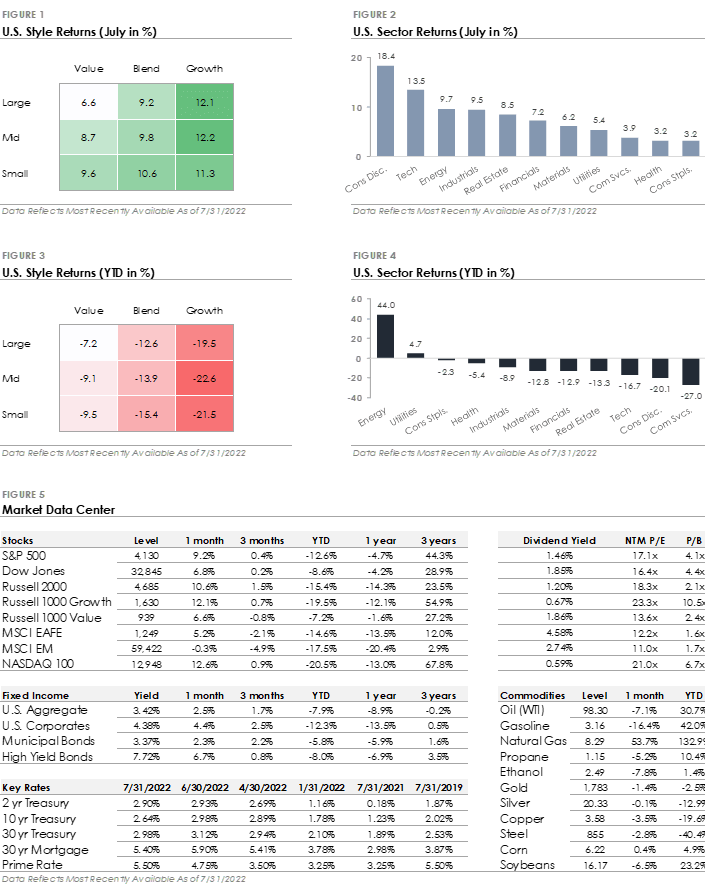July 2022 Market Summary
- The S&P 500 Index produced a +9.2% total return during July, underperforming the Russell 2000 Index’s +10.6% total return.
- All eleven S&P 500 sectors produced positive returns during July. Consumer Discretionary (+18.4%) and Tech (+13.5%) were the top performers after underperforming during the first half of 2022. Defensive sectors, such as Health Care (+3.2%), Consumer Staples (+3.2%), and Utilities (+5.4%), underperformed as the S&P 500 rallied.
- Corporate investment grade bonds generated a +4.4% total return, underperforming corporate high yield bonds’ +6.7% total return.
- The MSCI EAFE Index of global developed market stocks returned +5.2% during July, while the MSCI Emerging Market Index generated a -0.3% return.
Equity & Credit Markets Rebound After June Selloff
Stocks and bonds both rallied during July after selling off during the second half of June due to recession fears. Riskier asset classes, such as small cap stocks and high-yield corporate bonds, outperformed as investor sentiment turned slightly more positive. Why the change in attitude? Multiple catalysts could be causing the turnaround, one of which includes investor sentiment being too negative entering July. Second quarter 2022 earnings season kicked off during the month, and early results suggest Wall Street’s expectations were too low. While the rate of earnings growth is slowing, the overall tone appears to be less bad than feared with commentary from company management teams more optimistic than expected.
One interesting narrative starting to show up in headlines – weak economic growth could cause the Federal Reserve to stop raising interest rates sooner, which could boost investor sentiment and relieve pressure on stocks and bonds. Data indicates the U.S. economy shrank during the second quarter, which would mark the second consecutive quarter of negative GDP growth. Two consecutive quarters of negative GDP growth is the technical definition of a recession, and now there’s a debate about whether the U.S. is already in a recession. As discussed below, the prospect of a shorter interest rate hike cycle will be hotly debated over the coming months.
The Big Debate – Price Stability vs Maximum Employment
Congress has given the Federal Reserve a dual mandate to pursue price stability and maximum employment. What does this mean? The Fed defines price stability as ~2% annual inflation, but maximum employment is more difficult to define because many factors affect the structure and dynamics of the labor market. The Fed’s own definition acknowledges this: “The maximum level of employment is a broad-based and inclusive goal that is not directly measurable and changes over time …”
Where is the Fed’s attention focused currently? Price stability. The Consumer Price Index accelerated +9.1% year-over-year during June, which was the fastest pace since 1981. In contrast, the unemployment rate held steady at 3.6% during June. The Fed’s interest rate increases are intended to promote price stability, but they come with an embedded risk. Higher interest rates relieve inflation pressures by reducing demand for goods and services, which could slow economic growth. The risk is interest rate increases slow the economy and increase unemployment, pressuring the Fed to focus more on its maximum employment mandate and less on inflation and price stability.
The stage is set for a debate. Is price stability or maximum employment more important? The Fed previously stated it’s willing to accept higher unemployment and slower economic growth to bring inflation under control, but the question is how much. A lower tolerance for unemployment could cause the Fed to slow or stop its interest rate hikes sooner, while a higher tolerance for unemployment could give the Fed cover to continue raising interest rates higher and longer. The answer has major implications for both Federal Reserve policy and asset class returns.
Our Inflation Take
Our stance on inflation right now is neutral. While many think it to be transitory, we understand there are many forces driving prices, and the relationship between many of them is not fully understood or appreciated. If a price-wage spiral develops, the likelihood of persistent inflation is real. This scenario must scare the Fed, because when inflation becomes recognized as persistent and is no longer perceived as transitory, personal and business economic decisions change. Companies slow and profits sag. If this happens, it’s going to force the Fed to knock back a wage-price spiral.
This happened in the late 70s. However, P/Es on stocks were in the single digits during that time, and debt levels were negligible. Today, valuations are nearly four times those levels, and debt as a percentage of GDP is at levels considered unthinkable not that long ago. Fed monetary policy is much more influential on economic activity because of the enormous reliance on debt and interest rates. Accordingly, their policy actions and direct and indirect effects on liquidity greatly influence asset prices.
So, for now, The Fed is in the driver’s seat and how it reacts to our current inflation conundrum is going to dictate market returns for the foreseeable future.
Our portfolios will continue to remain in a cautious exposure, with the large portion of our holdings in short term cash ETF’s until it’s safe to return to a market with healthier underpinnings.
This Month in Numbers

Disclosures
CF Financial (“RIA Firm”) is a registered investment adviser. Information presented is for educational purposes only intended for a broad audience. The information does not intend to make an offer or solicitation for the sale or purchase of any specific securities, investments, or investment strategies. Investments involve risk and are not guaranteed. CF Financial has reasonable belief that this marketing does not include any false or material misleading statements or omissions of facts regarding services, investment, or client experience. CF Financial has reasonable belief that the content as a whole will not cause an untrue or misleading implication regarding the adviser’s services, investments, or client experiences. Past performance is not indicative of future performance.
CF Financial is not giving tax, legal or accounting advice, consult a professional tax or legal representative if needed.

